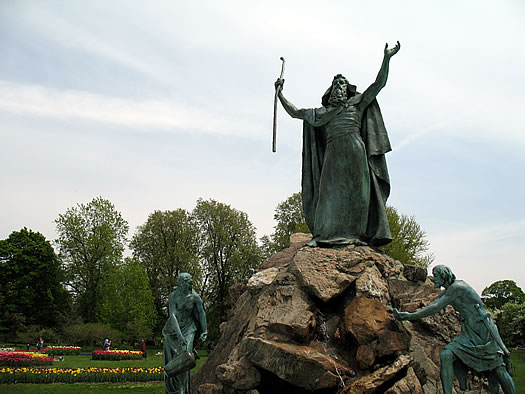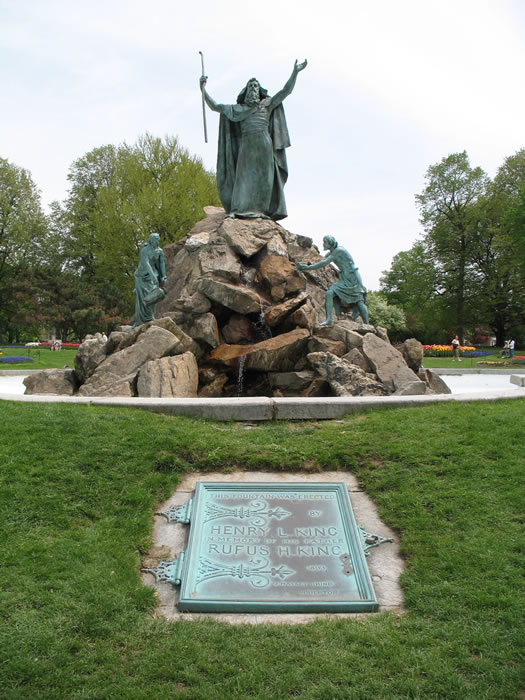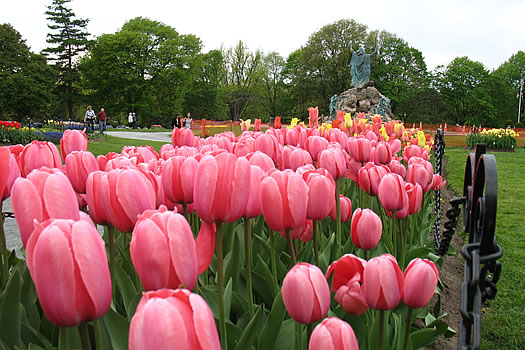The Moses fountain in Washington Park

And thou shalt smite the rock, and there shall come water out of it, that the people may drink.
Anyone in Albany knows the Moses fountain in Washington Park. But few know how this biblical tableau came to be one of the most striking features of the park, or why it is called the King Memorial Fountain.
So, why is this splendid fountain there -- and whom does it memorialize?

Rufus Henry King was born in Ridgefield, Connecticut, in 1794, the son of General Joshua King, a merchant and militia leader who was noted for having discovered the identity of Major Andre. Rufus set out to make his own fortune, moving to Albany to set up a dry goods store with his brother-in-law in 1814. His success in business led him into banking, in an age when local banks were vital to the growth and prosperity of the community. King became a director of the New York State National Bank, and became its president in 1860, devoting himself entirely to banking and gaining a statewide reputation. He became president of Albany Savings Bank in 1863, and also was president of the Albany Insurance Company, the oldest fire insurance company in the state. (If it seems odd to modern sensibilities that he presided over multiple companies, consider that his predecessor and successor at State National Bank both served as Mayor of Albany while running the bank.)
Cuyler Reynolds' genealogy of the King family captures the intimate relationship between banking, business and politics at the time: "The remarkable success of these three institutions speaks all that is necessary regarding his power as an executive. It has been said that financial officers of the state were accustomed to avail themselves of his knowledge and judgment as to time and character of loans, and he was always cheerful about giving advice which saved hundreds of thousands of dollars to the state's treasury." King was a lifelong friend and advisor of Thurlow Weed, the prominent Albany newspaper publisher and political leader who was a force in the Whig, Anti-Masonic and Republican parties.
Rufus King and his wife Amelia Laverty King had three sons, Henry Laverty, Joshua Howard, and Rufus Howard, and daughter Anna Josephine. All three sons attended Albany Academy and Union College. J. Howard King distinguished himself in the banking world, following squarely in his father's footsteps, becoming president of the New York State National Bank, Albany Savings Bank, and Albany Insurance Company. Like his father, he had political friends (including Union classmate Chester Alan Arthur), but no political ambitions. Young Rufus also joined the banks and insurance company, and served as paymaster-general to the Army of the Potomac.
Eldest brother Henry King followed the family's merchant tradition, never married, and appears to have built a comfortable fortune. He also served as an officer in the Civil War, brevetted as Colonel "for faithful and meritorious conduct through the war." Reynolds wrote that "he was a man of education and likewise of leisure, at the same time possessing a number of admirable traits of character, among them generosity and the ability to hold one's friends."

While J. Howard continued to build the family legacy, Henry chose to build a monument. On his death in 1878 at age 53, Henry left the sum of $20,000 to be expended in a public memorial to his father in Washington Park, which was to commemorate the Rock of Horeb.
In the Bible, Exodus 17:6, God tells Moses:
Behold, I will stand before thee there upon the rock in Horeb; and thou shalt smite the rock, and there shall come water out of it, that the people may drink. And Moses did so in the sight of the elders of Israel.
In the esteem in which commerce was held in the 19th century, the comparison of Rufus King's banking and mercantile skills to this provision of water "that the people may drink" was considered apt, and the smitten rock was a common image and subject in the literature of the age.
Some years passed, during which J. Howard King worked to increase his brother's bequest, before four sculptors were chosen to compete for the commission. John Massey Rhind of New York City, who was just beginning his American career, was selected over Daniel Chester French (Berkshire resident and sculptor of Abraham Lincoln); Ephraim Keyser, who designed the Chester Arthur memorial in Albany Rural Cemetery; and Charles Niehaus.
The fountain was constructed and finally unveiled in 1893. The New York Times gushed:
The treatment the artist has given Mr. King's suggestion will win for him a place among the foremost sculptors of the country. On a bed of rock, taken in its native state from Old Storm King Mountain on the Hudson, and laid artistically without the least use of a chisel, rises to a height of twenty-nine feet above the basin the noble and commanding figure of the great Egyptian leader and lawgiver. Besides the statue of Moses there are four other groups in bronze. The principal figure is ten feet in height and required 3,800 pounds of metal.
The Times also notes that "All [figures] were modeled after Hebrews, that of Moses being taken from a Hungarian Jew about fifty years old. The maiden, representing youth, was after the daughter of this man. The other groups represent infancy, manhood, and old age. All are endeavoring to obtain some of the water which gushes out of the rocks at the feet of Moses. The water does not spurt from the massive rock work, but flows in pretty cascades."
A week later, the Times noted that the King Memorial Fountain had been visited by thousands of persons during the week:
There have been many criticisms, some of which have not been favorable ... Some of the critics say that the fountain is not artistic and never will be, because it is impossible to combine rough ashlars and bronze figures in one harmonious whole. The arrangement of the figures, too, are said to be inartistic and rather stiff in the position in which they are placed. ...
But the common people, for whose benefit the fountain was erected, more than any one class, are satisfied, and admire the pile of rock and bronze, and feel proud that Washington Park has such an ornament.

Rhind, the sculptor, gained a national reputation and later created the statue of Gen. Philip Schuyler outside Albany's city hall.
And over time, the King Memorial Fountain has become one of the best-known and least-understood landmarks of Albany.
Carl writes about "random pieces of history from New York's Capital District" at his blog, My Non-Urban Life.
Earlier on AOA: The highway that was almost buried under Washington Park
Find It
King Memorial Fountain (The Moses fountain)
Washington Park
Albany, NY 12210
Hi there. Comments have been closed for this item. Still have something to say? Contact us.
Comments
Well told!
... said Joe Fusco on Apr 18, 2011 at 3:44 PM | link
Nice!
As a kid I used to wade in it, or just stick my feet in while sitting on the edge (depending on how clean it looked, of course :p).
... said kater on Apr 18, 2011 at 4:33 PM | link
Wait, it's not Poseidon?
... said Lu on Apr 18, 2011 at 7:48 PM | link
I thought it was Prospero when I moved here.
... said mr slow loris on Apr 18, 2011 at 8:52 PM | link
Moishe on Pesach! How appropriate!
... said Erik on Apr 19, 2011 at 12:35 AM | link
Rufus H. King was my gr-gr-gr-grandfather. I went to visit the fountain a few years ago, and the plaque had been damaged and vandalized. Seems like the money his sons left to maintain the statue might not be finding its way back. Anyone have information on that?
... said James P Colgate on Sep 29, 2012 at 1:30 PM | link
The stone masons that constructed this fountain were the Dodge Brothers from Pittsfield, MA, They also built significant buildings at Williams, Smith and Vassar colleges plus in Stockbridge, Pittsfield and Springfield MA. There were five brothers born in Honey Hollow in New Baltimore NY who were taught masonry by their father Elijah Dodge. My father proudly showed me this fountain when I was a boy many years ago.
... said James R. Dodge on Jun 5, 2014 at 8:52 PM | link
I am completing a book which deals in part with the Albany Burgesses Corps and other militias* active in Albany in the 1840s. Rufus King commanded the corps in that era. I would appreciate leads to relevant sources.
Howard Blue memrevs@gmail.com
* i.e. the Washington Riflemen. the Emmet Guards, the Van Rensselaer Guards etc.
... said Howard Blue on Jan 16, 2017 at 2:53 AM | link
Seems to be an unfortunate breach of 1st amendment .... separation of church and state, and it needs to be RELOCATED TO A CHURCH PROPERTY!
... said B Schneider on Jul 31, 2018 at 11:13 PM | link
@ B. Schneider
oh, not THAT again.
... said Eric Scheirer Stott on Aug 4, 2018 at 8:58 PM | link